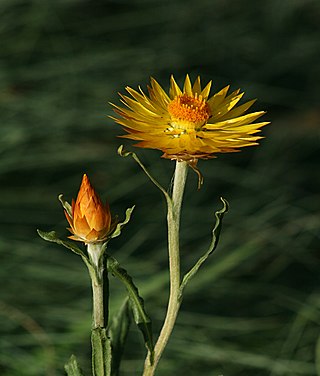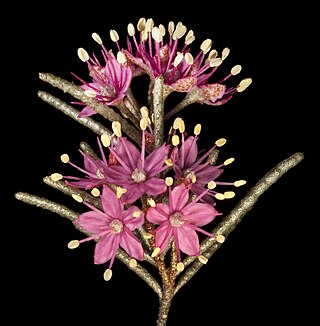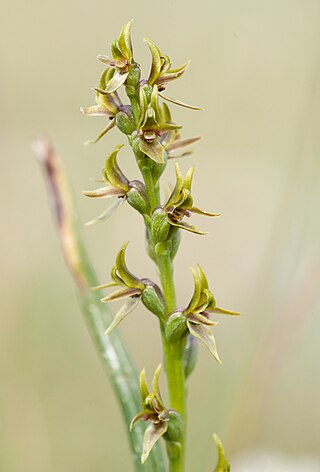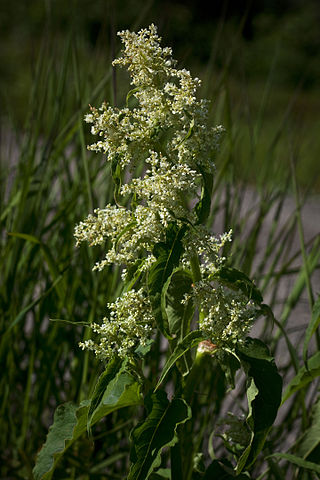
Gnaphalium is a genus of flowering plants in the family Asteraceae, commonly called cudweeds or (formerly) chafeweeds. They are widespread and common in temperate regions, although some are found on tropical mountains or in the subtropical regions of the world.
James Hamlyn Willis was an Australian botanist. He described 64 new species of plants, and published more than 880 works including the landmark two-volume A Handbook to plants in Victoria between 1962 and 1973.

Xerochrysum is a genus of flowering plants native to Australia. It was defined by Russian botanist Nikolai Tzvelev in 1990, preceding Bracteantha which was described the following year. A 2002 molecular study of the tribe Gnaphalieae has indicated the genus is probably polyphyletic, with X. bracteatum and X. viscosum quite removed from each other.
The Western Australian Herbarium is the State Herbarium in Perth, Western Australia.
Nuytsia is a peer-reviewed scientific journal published by the Western Australian Herbarium. It publishes papers on systematic botany, giving preference to papers related to the flora of Western Australia. Nearly twenty percent of Western Australia's plant taxa have been published in Nuytsia. The journal was established in 1970 and has appeared irregularly since. Kevin Thiele and Juliet Wege have been in the editorial committee.
FloraBase is a public access web-based database of the flora of Western Australia. It provides authoritative scientific information on 12,978 taxa, including descriptions, maps, images, conservation status and nomenclatural details. 1,272 alien taxa are also recorded.
Bruce Roger Maslin is an Australian botanist, known for his work on Acacia taxonomy.

Phebalium is a genus of thirty species of shrubs or small trees in the family Rutaceae and is endemic to Australia. The leaves are arranged alternately, simple and often warty, the flowers arranged singly or in umbels on the ends of branchlets or in leaf axils, usually with five sepals, five petals and ten stamens. There are about thirty species and they are found in all Australian states but not in the Northern Territory.

Neville Graeme Marchant is a retired Western Australian botanist. He was formerly the Director of the Western Australian Herbarium.

Vaccinium ovalifolium is a plant in the heath family with three varieties, all of which grow in northerly regions.

The flora of Western Australia comprises 10,842 published native vascular plant species and a further 1,030 unpublished species. They occur within 1,543 genera from 211 families; there are also 1,335 naturalised alien or invasive plant species more commonly known as weeds. There are an estimated 150,000 cryptogam species or nonvascular plants which include lichens, and fungi although only 1,786 species have been published, with 948 algae and 672 lichen the majority.

Xerochrysum viscosum is a flowering plant in the family Asteraceae. The plant is native to Australia, occurring in Queensland, New South Wales, Victoria, Tasmania and the Australian Capital Territory

Xerochrysum subundulatum is a flowering plant in the family Asteraceae, native to Australia, growing in Victoria, New South Wales and Tasmania.

Xerochrysum bicolor is a flowering plant in the family Asteraceae, native to Tasmania, where it is found in wetter habitats near the coast. It was originally described by Lindley in 1835 as Helichrysum bicolor, before gaining its current name in 2001.

Prasophyllum tadgellianum, commonly known as the alpine leek orchid, is a species of orchid native to the Snowy Mountains and Tasmania. It has a single stiff, erect leaf and up to twenty scented, greenish-brown or reddish-brown flowers crowded on a stout spike.

The National Herbarium of New South Wales was established in 1853. The Herbarium has a collection of more than 1.4 million plant specimens, making it the second largest collection of pressed, dried plant specimens in Australia, including scientific and historically significant collections and samples of Australian flora gathered by Joseph Banks and Daniel Solander during the voyage of HMS Endeavour in 1770.
The Australasian Virtual Herbarium (AVH) is an online resource that allows access to plant specimen data held by various Australian and New Zealand herbaria. It is part of the Atlas of Living Australia (ALA), and was formed by the amalgamation of Australia's Virtual Herbarium and NZ Virtual Herbarium. As of 12 August 2014, more than five million specimens of the 8 million and upwards specimens available from participating institutions have been databased.
Judith Roderick Wheeler is an Australian herbarium botanist. After receiving an honours degree in botanical science, she was employed at the State Herbarium of South Australia, before moving to Western Australia's Murdoch University and later the West Australian Herbarium. Wheeler was the leading contributor to the two volume Flora of the South West (UWAP).

Tanja Magdalena Schuster is a taxonomist from Austria, and the first Pauline Ladiges Plant Systematics Fellow, holding a joint position with the School of Biosciences, University of Melbourne, Victoria, Australia, and the National Herbarium of Victoria, Royal Botanic Gardens Melbourne. Schuster also worked as curator of the Norton-Brown Herbarium at the University of Maryland, College Park.

Xerochrysum wilsonii is a flowering plant in the family Asteraceae native to the South West of Western Australia.











